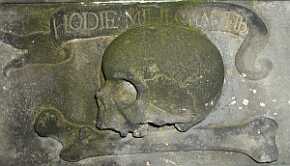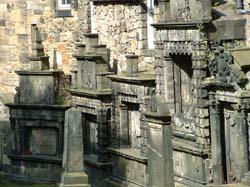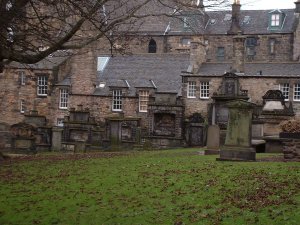
A Greyfriars grave carving.

|
*** Greyfriars takes its name from the fact it used to be a Franciscan monastery, as the monks were known as the "Grey Friars" because of the colour of their habits. In 1561, the country was in the middle of a religious upheaval. Until now Catholicism had been the predominant religion, but now Protestantism was taking over. Mobs destroyed the Greyfriars' Monastery, among other Catholic institutions in Edinburgh. The reformers made a Confession Of Faith, which served as a guide to how the Church would work from then on. The Church was divided up into Kirk Sessions, Presbyteries, the General Assembly and Synods. The reformers thought churchyards should not be used for burial, and requested that a seperate area of land should be set aside and used for burial only. They sent a petition to Mary Queen Of Scots saying the space where the Greyfriars' Monastery used to be should be converted into a graveyard. (Later on, a new church was built in the graveyard, which opened in 1620). |


|
In 1638, those who opposed Charles 1 signed a national Covenant in Greyfriars Kirkyard. This document proclaimed the Covenanters' loyalty to God, as opposed to the King- the Episcopalian church had the King at its head, taking the place of the Pope in the Catholic church. The Covenanters believed that the episcopailian church was far too similar to Catholicism. As events progressed, political unrest among the Covenanters increased. The government did all they could to stop them, and Covenanter leaders were frequently killed. In 1679, the Covenanters battled Charles II (Charles I's son)'s forces at Bothwell Bridge on the River Clyde. They found themselves outnumbered and were easily defeated. More than a thousand of them were taken prisoner and returned to Edinburgh. As the prisons in the city did not have room for such a high number of new inmates, they were imprisoned in an area of land by Greyfriars Graveyard. They had no shelter and little food. As they spent a whole winter imprisoned in that place, many of them died. Still more were publicly executed. These people were buried in Greyfriars, and the Martyr's Monument can be seen in the kirkyard today, a memorial for the Covenanters. Some were set free, on the condition that they signed a contract promising they would never raise arms against their King again. Some refused, still faithful until the end. By then, Covenanters had decreased hugely n numbers, with less that three hundred men remaining. The King planned to sail them to the West Indies ans sell them as slaves, but the ship they were on was wrecked near Orkney. The piece of land now known as the Covenanters' Prison is not actually where they were imprisoned. The original prison has been built over- it's somewhere under Bristo Place to the South-East of Greyfriars. The place known as the Covenanters' Prison was not added until 1703. ***  Some graves in Greyfriars. |


|
But surely there must be something there? After all, hundreds of people have all entered the graveyards and suffered the consequences. Classic poltergeist phenomena abound, inculuding cold spots, strange noises and physical attacks leaving bruises and scratches. People have even been knocked unconscious. It may not appear to be the best documented anything (when does stuff become a "document"?), but you can hardly blame the tour company for going for a bit of extra publicity, right? The Edinburgh ghost tour market is a very competitive one... Who was Mackenzie anyway, and why is it named after him?  George Mackenzie (1636-1691) was a lawyer and Lord Advocate during King Charles II’s reign. His violent methods of torturing and killing the covenanters earned him the nickname “Bluidy Mackenzie”. George Mackenzie (1636-1691) was a lawyer and Lord Advocate during King Charles II’s reign. His violent methods of torturing and killing the covenanters earned him the nickname “Bluidy Mackenzie”.When he died he was buried in Greyfriars Graveyard, in a large, black, showy offy mausoleum. It was said that because of the horrific things he did in his life, he could not rest in death. Children used to dare each other to knock on the door of his tomb and yell “Bluidy Mackingie, come oot if ye daur, lift the sneck and draw the bar!” then run away before his corpse rose from its coffin. The poltergeist has been named after Mackenzie because of an incident that happened just before the poltergeist started showing up. Theoretically, a homeless man looking for shelter came into the graveyard looking for shelter on a rainy December night. The gate had been left unlocked by mistake. In The Ghost That Haunted Itself, the BBC gets the blame for driving a truck into the east gates. And leaving it. (Trust the BBC...) This homeless man then decided to try to get into Mackenzie’s tomb, as it was one of the most sheltered ones in the whole graveyard. He looked through the grille at the front and must have seen a small crack of light. (This story must be 99% educated guess because nobody can ever know what the homeless man did. . . .) Intrigued by the light, he climbed over some railings and saw a small opening at the back of the tomb where it nearly connects with the graveyard wall- the railings run between the mausoleums near the wall. (In recent years the railings ave managed to come down one way or another, prolly vandalism, but now anyone can get to the back of Mackenzie’s tomb. There is a very tiny aperture and it’s possible a small person could squeeze through. Only just, but stranger things have happened and were just about to.) The homeless man found he could fit through and, once inside, saw there was a stairway down to a vault below where the bodies actually went. He found several coffins and attempted to open one, as there may have been something valuable buried with the bodies- they were nobility, after all. Meanwhile, a man was walking his dog in the graveyard. This begs several questions. The main two being: 1. The graveyard’s normally locked. What made him choose that night to go a different way and investigate Greyfriars? 2. Why was he walking his dog after midnight? The homeless man apparently entered around 11pm and he’d been checking out the tombs for a while. It is possible he had odd work hours though. So, it’s about midnight, raining heavily, and there is a graveyard with open gates. That you KNOW are meant to be closed (We assume he’s lived in Edinburgh a while- it’s even more unlikely he’s doing this not knowing the city very well And if they got a van driven into them they’d be bloody bashed, wouldn’t they?) So whaddaya do? Walk straight in, of course. The stars are just right for the Call Of Mackenzie! ^^; Anyway, the dog walker heard the homeless man trying to get into the coffin, and wandered towards the tomb wondering what was making the noise. Then the homeless man fell through a hole in the floor into a pit full of mouldy skeletons. As you would be, he was terrified, and ran into the tomb. The dog walking man thought he was Mackenzie’s ghost and ran away. The homeless man thought he was running away from a zombie behind him and ran after the dog-walking guy. Who thought the zombie was chasing him. (What is this, Scooby-Doo or something?) We can only assume the dog walker informed the police about this because apparently they investigated the tomb. They didn’t know why there was a hole in the floor leading to a pit full of corpses either. Well, why *should* they? (Never question the workings of the arcane and bizzare Victorian-era Edinbvrgh Council.) And burial methods were always just plain random in that graveyard. As an indicator of how accurate that story is, the last time I was on the tour, the dog walker had been changed to a caretaker. Makes more sense as a story. Makes less sense on the "well, why wasn't he a caretaker in the first place" issue. In "The Ghost That Haunted Itself"'s first edition, there is no mention of a caretaker. I really wouldn't know about later editions. A little while after this disturbance the Mackenzie Poltergeist became active. The first instance was at the Mackenzie Mausoleum when a woman looking through the grille at the front was knocked backwards by a blast of cold air. It is possible that this was not the first case of the poltergeist- in his book "The Town Below The Ground", Jan-Andrew Henderson mentions something that might have been a young Mackenzie poltergeist terrorising tourists in the South Bridge Vaults. ( More on that here) City Of The Dead Tours (run a tour around Greyfriars, and this tour is the only way to get into the Black Mausoleum) put forward these disturbances as what started up the poltergeist. It was named The Mackenzie Poltergeist after the fact the first attack was by his tomb. However, that was the only incident around Mackenzie’s tomb. After that the poltergeist moved into The Black Mausoleum, a little tomb in the Covenanter’s Prison with no connection to Mackenzie. Nobody knows who’s buried there- the Black Mausoleum has no name on it at all. Could it really be the ghost of Mackenzie then?  The main attraction of the name “Mackenzie Poltergeist” was that George Mackenzie was famous. Even better- he was *infamous*. How cool is it to have an evil, dead celebrity bashing your tourists’ heads in? The main attraction of the name “Mackenzie Poltergeist” was that George Mackenzie was famous. Even better- he was *infamous*. How cool is it to have an evil, dead celebrity bashing your tourists’ heads in?There’s not any evidence that the poltergeist is the ghost of *anything*. It’s never spoken- although laughing has been heard- but it certainly hasn’t shown any signs of being a person. Poltergeists are never usually a “personality” ghost- but they do seem open to suggestions. In the case of “The Black Monk Of Pontefract” , a poltergeist showed up as a figure in a monk’s black habit after someone mentioned in its presence that a monk was hanged in the haunted area. There later proved to be no actual historical record of the hanged monk. The Mackenzie Poltergeist hasn’t shown signs of taking suggestions yet, but, if it ever did, it’d be likely to do something to show that it WAS Mackenzie- after all, people have been calling it that since the beginning. Think of that, and tremble! It’s certainly better-natured than a lot of poltergeists, when it comes to appearances. Poltergeists often tend to make themselves known to only a few people, and not to visitors. This hardly convinces people those who do witness it are telling the truth. But “Mackenzie” has been turning up as a regular crowd-pleaser. It could be because it enjoys the attention, and, seeing that it gets it, it feels safe. People enjoy coming to see it, and if it does have a “mind”, it thinks no-one’s out to exorcise it. exorcism has been attempted in the past. It failed miserably, and the poltergeist, hyper on its victory, got stronger. If it’s not someone’s ghost, what is it?  Well, nobody has proved yet what poltergeists actually are. There are plenty of theories though. Many involve the presence of one person as a focus. This is, of course, impossible with the Mackenzie Poltergeist. Even the tour guides change from day to day. Well, nobody has proved yet what poltergeists actually are. There are plenty of theories though. Many involve the presence of one person as a focus. This is, of course, impossible with the Mackenzie Poltergeist. Even the tour guides change from day to day.In his book “Poltergeist! A Study In Destructive Haunting”, Colin Wilson suggests that , as a theory for the Black Monk case, that ‘the ground itself contains some peculiar force that favours manifestations.’. The force needed a “provider-of-energy” to actually make itself known but it was there all along. Using this theory, who could be the “provider-of-energy” for the Mackenzie Poltergeist? Perhaps all it took was the disturbances in Mackenzie’s tomb to unleash the energy. Instead of waiting for someone to “channel” itself though, it needed someone to knock it out of resting into reality. That doesn’t really explain it too well though. Maybe the “force” in the ground was so strong it didn’t need a channel. Greyfriars has a long history and none of it is too peaceful. The energy could have been slowly accumulating over the years until it had to become physical, tangible, even destructive. After all, Greyfriars’ history didn’t stop once the Covenanters and Mackenzie died. Thousands of people are buried there. The famous ones are recorded, but many, many more are not. Hundreds of anonymous bodies lie there. Who knows what their lives were like? How many of them were not ready to die? Unmarked graves mean there’s no way of finding out. It could be that the breaking into Mackenzie’s tomb added the trauma of the homeless man (trapped in a tomb, he was terrified when he found the mound of bodies, plus maybe even the other troubles of his life) to the already deep energy pool collecting in the graveyard. This made it overflow. Another theory taken from "Poltergeist! A Study in Destructive Haunting" (by Colin Wilson) which perhaps fits the Mackenzie Poltergeist more is that off the Elementals. Elemental spirits take some of their energy from the site itself, and some from people. However, they do not latch on as one specific focus. The example given in Poltergeist! is that of the King's Cellars pub in Croydon, England. This poltergeist was active in the late 1970s and early 80s, and it behaved in a typical poltergeist manner: bottles and glasses would smash or float above the bar, there would be chills and cold spots, and tills would malfunction. Obviously in an empty tomb there's a lot less things to smash, but there's plenty of cold spots in the Black Mausoleum. In Croydon, the poltergeist had been active since the King's Cellars first opened. Its actions built up until, eventually, toilets flooded, the entire bar would become so cold it coud not be used, and once a fire spread up the wall and over the ceiling, before suddenly disappearing. There were no electrical faults- or for that matter, no conceivable cause of a fire at all- in the building. Like the poltergeist in Greyfriars, it never payed special attention to any one person. It mostly manifested itself with only bar staff present, but sometimes made itself known when the pub was full of customers. It showed no sign of finishing the haunting, either, unlike most single-focus cases- and just like "Mackenzie". It was thought that the Croydon haunting could be connected with a girl who had thrown herself off the building opposite, landing on the pub's roof. This would have made it a normal haunting, but this kind of behaviour was unmistakeably poltergeist, not ghost. Much like the Mackenzie Poltergeist, an average ghost just doesn't explain the goings-on, although a normal ghost would be very plausible in the circumstances. But if it's not a normal ghost, and doesn't act like an average poltergeist, what the hell can it be?  In Poltergeist, Wilson brings forwards a theory of 'Elementals'. One kind of elemental, the kind in question here, is conjured up by a person, but once it has been created it is no longer under that person's control. they tend to remain in the place they were created until someone can get them to dissolve. Elementals of this kind are also known as "thought-forms", which is a very good explanation of what they actually are. They're like thoughts which have taken on a mind and life of their own. They can be created unintentionally, if someone chances upon the right method of making one without realising. No physical materials are needed, but with very intense emotions, someone can find the right force and invoke it without realising. In a place like Greyfriars, there would have been intense emotions all over the place. Perhaps it was the homeless man who accidentally created a thought-form, or perhaps he let one loose from inside Mackenzie's tomb. Perhaps a visitor to the graveyard created it, recently or when people were still being buried there. In Poltergeist, Wilson brings forwards a theory of 'Elementals'. One kind of elemental, the kind in question here, is conjured up by a person, but once it has been created it is no longer under that person's control. they tend to remain in the place they were created until someone can get them to dissolve. Elementals of this kind are also known as "thought-forms", which is a very good explanation of what they actually are. They're like thoughts which have taken on a mind and life of their own. They can be created unintentionally, if someone chances upon the right method of making one without realising. No physical materials are needed, but with very intense emotions, someone can find the right force and invoke it without realising. In a place like Greyfriars, there would have been intense emotions all over the place. Perhaps it was the homeless man who accidentally created a thought-form, or perhaps he let one loose from inside Mackenzie's tomb. Perhaps a visitor to the graveyard created it, recently or when people were still being buried there. Some of the effects- the scratches- could be related to the "Hand Of The Devil" game. The way this game works is: One person tells another person a story which goes something like this: You are getting ready to go for a night out. You're putting on your best clothes, and doing your hair, and then the doorbell rings. You open the door and all your friends have arrived in a taxi. You get into the taxi and you all go into town and go into a bar... It carries on in this vein, and the person listening to the story has to picture it all very clearly. Then, as the story goes, : you meet a stranger in the bar who offers to buy you a drink. You turn around to talk to them and as you do you you feel three... long... scratches... on your back. And this was the hand of the DEVIL! At this point, the storyteller runs their hand *very lightly* down the person's back. The person should, if they have been imagining it well enough, have three long scratches on their back. And that has WHAT do do with the poltergeist? Imagine the scene: You are going for a night out. You're getting ready, and then your friends arrive at the door... You go into town and decide it would be a laugh to go on a ghost tour...... When you're in the graveyard, you are being told about all the things the ghost has done to other people, or the infamous caretaker/ dog walker/ grave robber/ whoever he was story. If you have an active imagination, you never know... In the past, the Devil's Hand story has worked on me, even though I know there's no way it's real. The poltergeist story has also worked on me: four scratches on my right leg. (N.B- this happened a while after I had heard of the poltergeist, and this webpage was already up and running. Having been obsessed with the poltergeist for a significant amount of time, could it have meant more imagination had already gone into the story?) Obviously this theory doesn't explain cold spots, or why it started in the first place. But it could help to explain why the poltergeist attacks so many people, and why it shows up on a ghost tour regularly, whereas most poltergeists would do precisely the opposite, just to annoy the tour guides. The fact remains that nobody knows what the poltergeist is, and it's all hype and guesswork . |
 George Mackenzie's Tomb  A Wall of Gravestones...  And this is what the tourists come here for! "The best-documented irritating dog in history!"  View My Guestbook Sign My Guestbook If you have a question about the poltergeist, please email to greyfriars_poltergeist@mailpanda.com.  |
